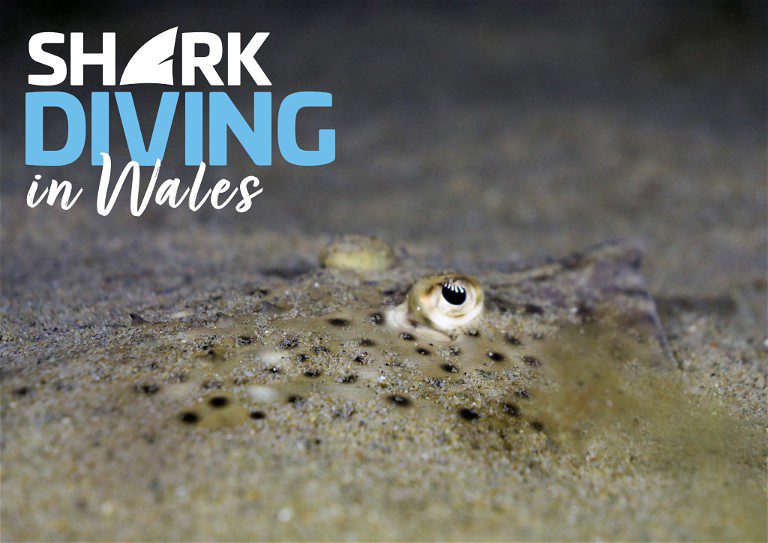When you say ‘sharks’, most people think about the warm, blue waters of the tropics with large pelagic species. However, you don’t have to travel far to see some incredible shark, skate and ray (elasmobranch) species, as Jake Davies explains.
Photographs by Jake Davies
Discovering the Rich Biodiversity of the Welsh Coastline
The UK coast is home to a diverse range of elasmobranch – within coastal waters, there are over 35 different shark, skate and ray species that can be found, with even more seasonal species that can occasionally be seen, and others being more deep water species found off the continental shelf.
For me, it’s the Welsh coastline that has delivered many of these species, where I’ve been fortunate to see a number of them, from one of the world’s rarest sharks, the angel shark (Squatina squatina) to more-common species, such as the lesser-spotted cat shark (Scylionrhinus canciula). Since first starting to dive over seven years ago, seeing any of the shark species is always exciting – it’s a moment to appreciate an animal that’s been around for millions of years, where it’s perfectly evolved to its environment. By spending more and more time with the species, you can see how they have adapted to these particular areas, whether it’s the open ocean, reefs, or on the sand. For each, they have characteristics that helps them thrive in these areas.
Exploring the Reefs: A Haven for Lesser-Spotted Cat Sharks and Bull Huss
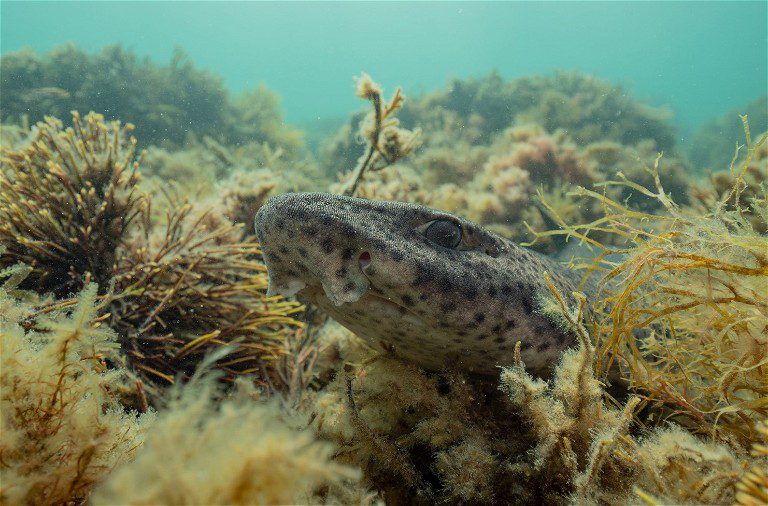
Heading onto reefs, from large gullies to boulders full of algae, lesser-spotted cat sharks (Scyliorhinus canicula) and bull huss (Scyliorhinus stellaris) are the two species that are likely to be seen. If it’s not the individuals themselves, there’s a likelihood of finding their egg cases – also known as mermaid’s purses – connected to seaweed. Both species perfectly camouflage into the reef and unlike oceanic species, they’ve adapted to be able to rest on the seafloor through the use of small openings behind their eyes called ‘spiracles’, which allow them to pump water over their gills without having to actively move. This is the reason they are often found just sitting among the reef or sheltering within gullies and among boulders.
Unveiling the Mysteries of the Deep: The Glowing Sharks
For many, these species are often overlooked as they are common, but over the years, I’ve had many special encounters with both species, in particular the lesserspotted cat sharks, from diving on reefs that are full with recently hatched pups to capturing incredibly rare footage of mating behaviour to watching them glow at night.
This latter feature is something that has only been recently discovered thanks to the use of UV lights for diving. Around the world there are a few shark species that glow when using UV light and a yellow filter, of which some of the most well-known are the puff adder shy sharks in South Africa (Haploblepharus edwardsii)) and chain cat sharks (Scyliorhinus retifer) found in the Northwest Atlantic glow green under the light.
However, species such as the lesser-spotted cat shark does the same – under UV it produces a vibrant green colouration which is really unique to see, and another example of how sharks still surprise us and that even some of the morecommon species shouldn’t be underestimated.
The Hidden World of Skates and Rays
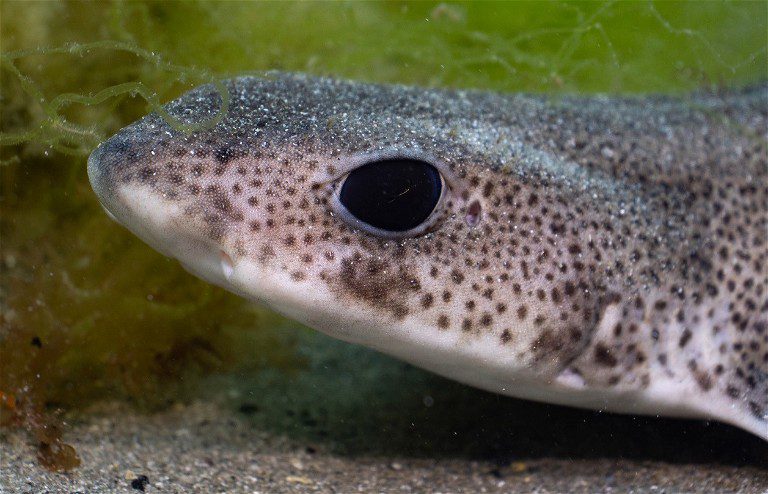
Did you know?
The diamond-shaped spotted ray is one of the smallest skate species. It has a varied diet, eating crustaceans, worms and fish. The young often live in shallow areas near the coastline, known as nursery grounds, but adults are typically found further offshore.
Diving onto more gravelly or sand substrate, you tend to find more of the skate and ray species, where their flat bodies allow them to bury into the substrate and remain hidden, where their skin pattern allows them to blend in. This adaptation and behaviour is perfect in this environment, as anything above would stand out and wouldn’t have the element of surprise.
The Angel Shark Project: A Journey of Discovery and Conservation
Off the Welsh coast, the skates such as the blonde (Raja brachyura), thornback (Raja clavata), small eyed (Raja microocellata) and spotted (Raja montagui) are more of the common species that can be found, Often referred to as ‘rays’, these are actually skates as they also lay eggcases which have a sticky covering that hides them when laid on the seafloor. True ray species can be found along the coast, species such as the stingray (Dasyatis pastinaca), however, records are very few and far between especially from snorkellers and divers. Hopefully a species that can be filmed below the surface of the Welsh coast one day.
A Memorable Encounter with the Angel Shark
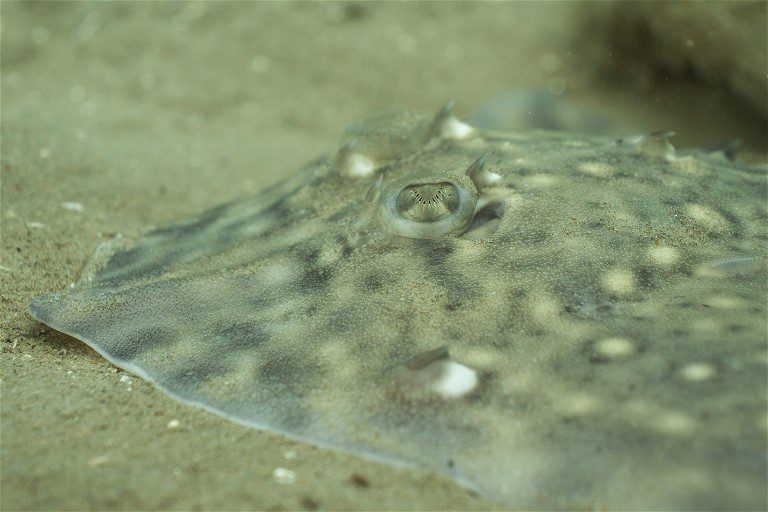
Many of the species are found hidden in the sand, and there’s one in particular that has been the focus of growing interest off the coast over the years and that is the critically endangered angel shark (Squatina squatina).
It’s been great to help better understand the species through the launch of Angel Shark Project: Wales in 2018. The project, which works closely with fishers and coastal communities in Wales, has had over 2,200 records shared which date back to the 1800s, and along with these, many historic and recent photos which help to better understand the species’ distribution, biology and ecology in the area. Many of these records have been shared by fishers who had historically caught them, or who have caught them accidentally in the recent years, as since 2008 they are a protected species due to their listing on the Wildlife & Countryside Act.
This was a shark species that I learned a lot about over the years studying it, but also one that was high up on my list to see and film off the Welsh coast, especially because no one had done it around the UK coast. A Bank Holiday Monday in August 2021 was when a day I had only dreamt about came true. A day which could have been completely different as there was a decision to either continue with house renovation work or go for a dive with the club – luckily, like most outcomes, ‘to go diving’ was the correct decision.
To be able to have not only see an angel shark but also film one was an unforgettable moment, and one that may never happen again. It was a real privilege to spend time with such a unique shark species, one that very few people have seen below the surface around the UK coast.
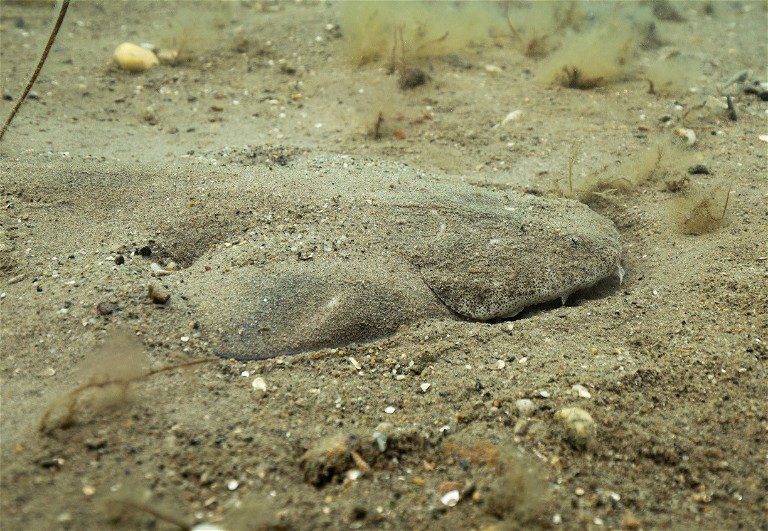
Venturing into the Open Ocean: A Realm of Larger Shark Species
Heading into the open ocean, you can find a few more of the traditional shark species – the Welsh coast hosts many more than people think. Found in the open ocean is one of the largest fish in the oceans, the basking shark (Cetorhinus maximus), which can be occasionally seen around the coast, but tend to be found further offshore.
There are also occasionally sightings of leaping thresher sharks (Alopias vulpinus) and anglers catching mako sharks (Isurus oxyrinchus), which are one of the fastest sharks found swimming in the oceans. Encountering these species below the surface would be unlikely, but two ocean wonders that can be seen are the blue shark (Prionace glauca) and the porbeagle shark (Lamna nasus). From mid-June to October, you can head out into the Irish Sea and get into the water with blue sharks, and if you are lucky a porbeagle may show up, but they are a fairly shy species. Blue sharks are true ocean wanderers, travelling thousands of miles around the Atlantic Ocean.
Over the years, more and more people are visiting the Welsh coast to head out from Pembrokeshire to get in the water with them and experience what it’s like to be up close and personal with a larger shark species without having to travel overseas. This is a species I’ve yet to get in the water with – three planned trips have been cancelled prior to setting off due to poor weather, and the fourth ended up out in the Celtic Deeps but unfortunately, no sharks turned up. Pelagic sharks may be where my luck for filming sharks runs out, with more success filming the flat, cryptic shark species.
Across all of these different locations, there are chances of seeing other shark species that aren’t frequently seen, but historically were more abundant or tend to be found in deeper waters. Species such as smoothounds (Mustelus asterias), which historically were a common species, can be encountered on some shallow dives. If you do see one, the likelihood is you’ll see a few more, as they travel around in packs close to the seafloor.
Starry smoothounds (Mustelus asterias) tend to be found in deeper water but are infrequently seen and always a pleasure to see during a dive.
There are other species that are known to be found off the Welsh such as flapper skate and spurdog (Squalus acanthias), however over the years their numbers have declined and they are species that tend to be found in deeper waters. But, around the UK coast, they can still be found especially around the lochs off the west coast of Scotland. During a trip in 2021, I was fortunate to be part of a team who filmed flapper skate (Dipturus batis) in a loch in Scotland, again a species that I’d thought I’d never see due to their critically endangered status. However, during these dives, we were fortunate to see them on three out of five dives, where they glided like spaceships along the seafloor out of the darkness, then quickly disappeared back out as fast as they had appeared.
Conclusion: Celebrating the Rich Marine Life Closer to Home
No matter where you are in the world, the seas will constantly surprise you – when you think of sharks, you don’t have to travel too far to find them. Next time you think about getting in the water with sharks, think closer to home, where Wales might be your destination to have an experience with these incredible creatures, whether it’s with cat sharks on the many great reefs, or with blue sharks in the ocean waters of the Celtic Deep. Each moment you spend with them, just think that these have been around for millions of years, and it’s something to cherish while celebrating their importance in keeping the seas healthy.
This article was originally published in Scuba Diver UK #73
Subscribe digitally and read more great stories like this from anywhere in the world in a mobile-friendly format. Link to the article
